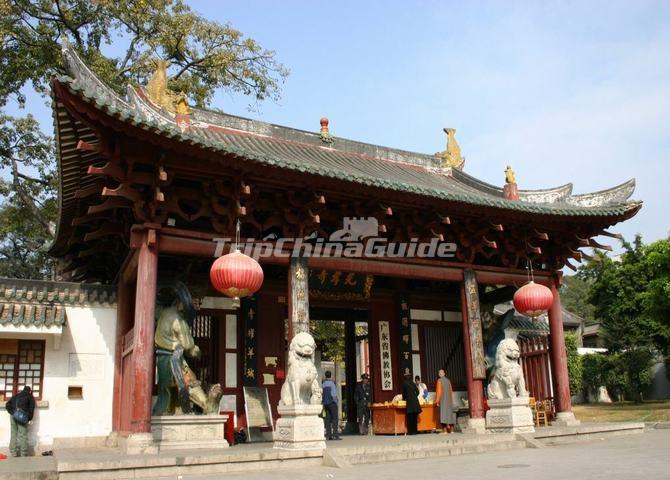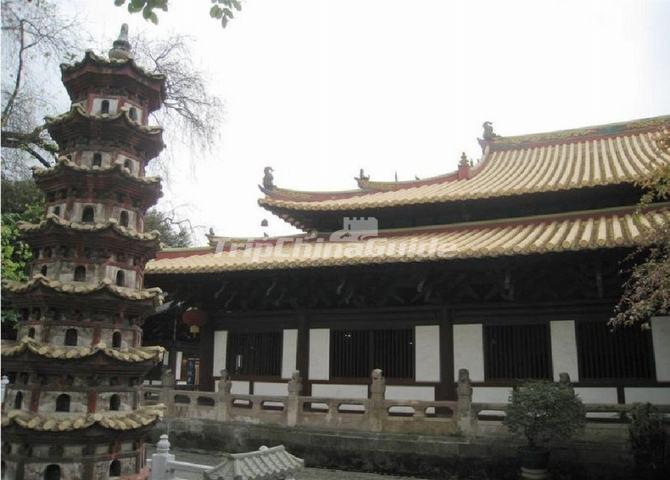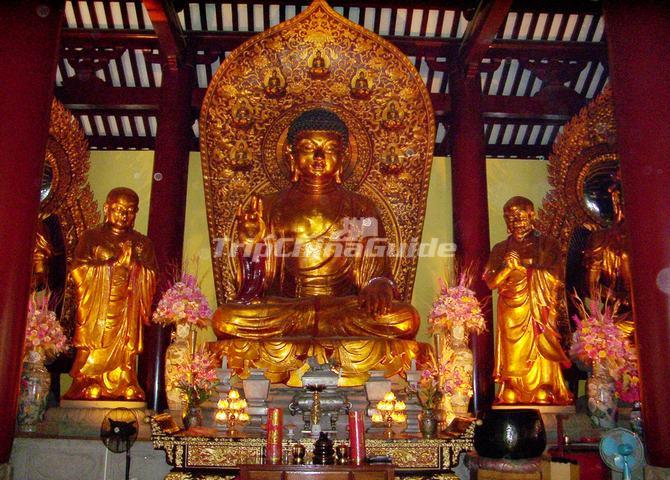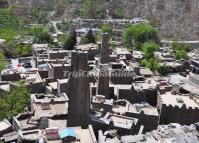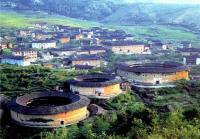Bright Filial Piety Temple
Among the historical sights in Guangzhou, Bright Filial Piety Temple (aka Guangxiao Temple) enjoys the longest history (more than 1500 years) and is the richest in cultural relics. Kaiyuan Temple in Chaozhou, Nanhua Temple in Shaoguan, and Qingyun Temple in Zhaoqing and Guangxiao Temple in Guangzhou are well known as the four most famous temples in Guangdong Province. As Cantonese put it, Guangxiao Temple comes before Guangzhou City, revealing its long history. Located on Guangxiao Road, Guangxiao Temple covers an area of 31000 square meters and tops the list of Buddhist temples in South China. Along the axis line, from south to north, there are the Shaomen (the mountain gate), Hall of Heavenly King, Hair Burying Towered. On the west side are Stone Pillars of Infinite Mercy, West Iron Tower, etc.; on the west side are the Hall of the Sixth Ancestor, the Corridor of Steles, etc.; eastward still are Sleeping Buddha Pavilion, East Iron Tower, and etc.
Bright Filial Piety Temple is famous not only for its long history and rich cultural relics, but also for the fact that many culture celebrities and Buddhist dignitaries have ever stayed here, making it a center for culture exchange between the south and central parts of China and a place for spreading Buddhism in the south. Among the numerous dignitaries is the most famous master Huineng (wisdom and ability), the founder of the southern school of Zen Buddhism. The mention of his name reminds people of his well known Buddhism chant: "There is no tree in Bo-dhi, Norms justice the Bright Mirror, since everything is but nothing, where can dust a stir?" It is said that the place where Huineng had his own tonsurewas was just under the Bo-dhi tree in Guangxiao Temple.
Front GateOn the front gate of Guangxiao Temple, there is a couplet about the evolution of Guangxiao Temple; Discussing the old tree at the city of Five-goats, visiting Ke woods for the first stop .Here the old tree refers to the bodhi tree planted by Buddhism monk zhiyao (wisdom and medicine), and first stop refers to the landing place of Guangzhou since Budhidharma sailed eastward. Yufan planted some Kezi trees, so Ke Woods is another name of Guangxiao Temple.
Hall of Heavenly King
The stature in the middle of the Hall of Heavenly King is Maitreya Buddha, familiar to most of us. On his both side are the four Heavenly kings with sword, lute, umbrella and dragon –snake in their hands, symbolizing favorable weather, a good wish of the people for a nice life.
In the middle of Daxiong Bao Dian (Mahavira Hall) is sakayamuni. Sitting cross-legged, left hand on left foot, right hand holding up, he is giving a lecture to the audience. There is a one-thousand-arm-eye Kwan-yin statue behind Sakayamumi. One thousand arms means offering protection for all the people and one thousand eyes means watching the whole world over. It is an indication of infinite benevolent power.
The stature in Sleeping Buddha Pavilion, 4 meter long and more than 6-oll tons of weight, is carved white marble from Burma. It is the nirvana’s state of Sakyamuin, sedate and natural, hence the model of all the sleeping Buddha statures afterwards.
Hair Burying TowerThe seven-stories Hair Burying Tower is 7.8 meter in height. There are 8 little figures of Buddha on each storey. The base of the tower is built by red sandstone. The tower looks elegant. As a tower of Tang Dynasty, it’s very few of its king in our country. In676A.D. Huineng named it Giangxiao Temple while the Pinzon rabbi was giving a lecture. A breeze swung the long narrow flags in the temple, which caused a dispute disputes among the shaman. Some said it wind that moved. His words won the respect of the shaman. Thus Yinzong rabbi made Huineng has his tonsure just under the bo-dhi tree and called him master. Later a tower was build to bury Huineng’s hair. From then on, Huineng because the leader of southern school of Zen Buddhism. Guangxiao Temple hence gained its popularity both at home and abroad.
Bo-dhi Tree
The flourishing tree here is Bo-dhi tree. Unfortunately, the one planted by Buddhist monk Zhiyao (wisdom and medicine) was destroyed by typhoon in Jiaqing reign period, Qing Dynasty. This one is transplanted from Nanhua Temple in Shaoguang, with its origin in Guangxiao Temple. It’s more than 180 years old now.
Hall of Sixth Ancestor
The Hall of the Sixth Ancestor is in honor of Huineng. It was first built in Zhengzong's reign period, Song Dynasty, followed by repair for several times. This is the stature of Huineng, sedate and wise. There is a story about him. While the fifth ancestor Hongren (board-minded and tolerant) was giving lectures in Dongshan Temple, Hubei Province, he felt he was old and weak, and considered abdicating his post to a monk with enlightened mind. For equal chance, all the monks were required to write a poem on the white wall of the temple to show their wisdom and qualification. Huineng’s poem impressed Hongren most and Hongren asked an interview of Huineng. But Hongren did nothing during the interview accept 3 knocks on Huineng's head and left. Huineng was wise enough to perceive he was asked to meet Hongren in his bedroom at midnight. There he got his Buddhist appliance and his Buddhist name Huineng and became the 6th Ancestor, Zen Buddhism. Just in that evening he was sent off to the south, Later, Huineng had his tonsure here under the bo-dhi tree and became the leader of southern school Zen Buddhism.
East Iron Tower
Behind the Grand Hall, there are two iron towers on both sides. They are the relics of Southern Han state. The one on the east side was founded in 967 A. D. by Liu Biao, the ruler of Southern Han State. Being the largest, oldest and best preserved, the iron tower reveals a refined arts and crafts. It is recorded in history books that there once were one thousand gold coated little figures of Buddha. The iron tower on the west side was built in 963 A. D. later it was crushed into halves because of the collapse of the hall.







